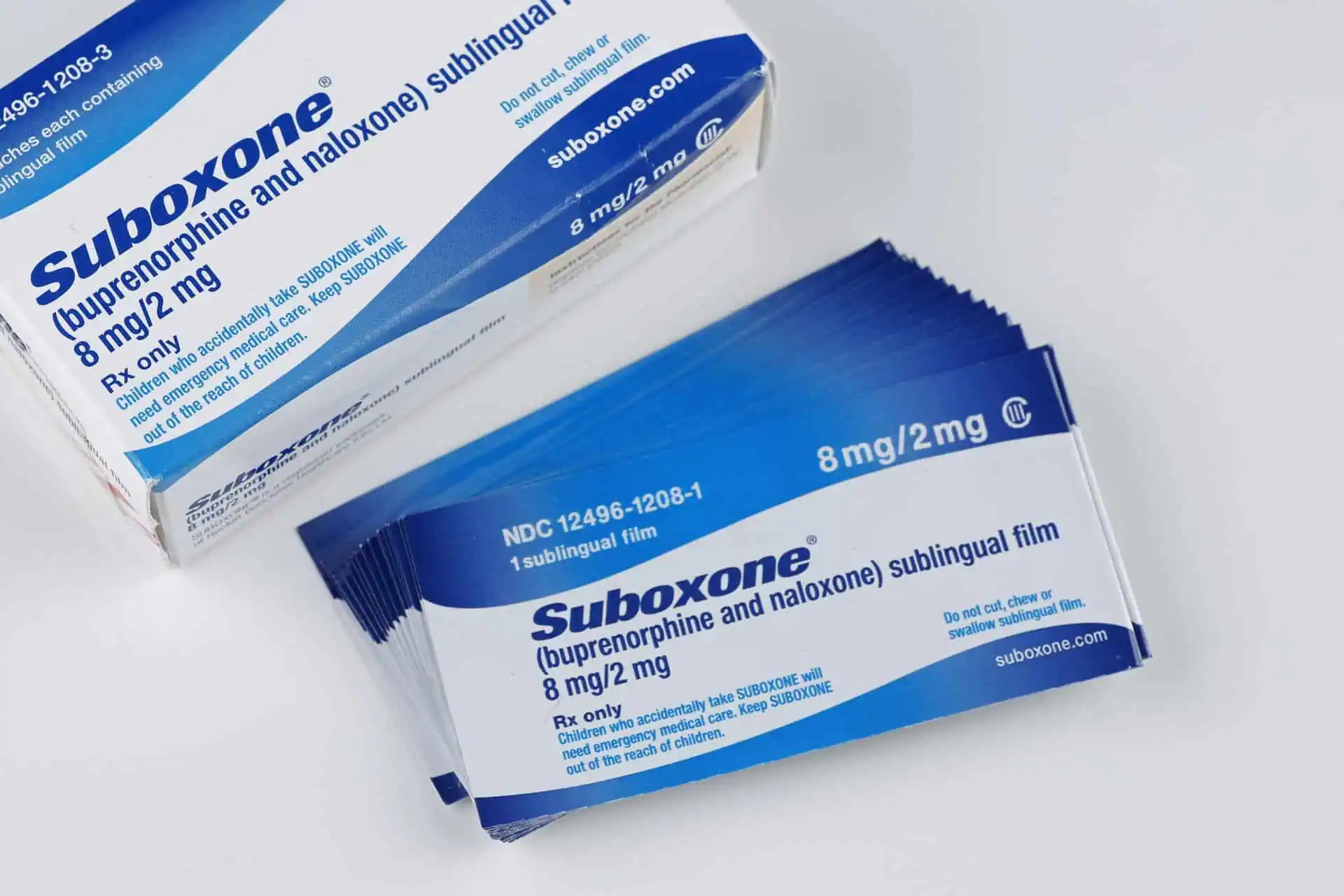Suboxone Lawsuit Ohio MDL Consolidation
- Last Updated: July 14th, 2025

Attorney Jessica Paluch-Hoerman, founder of TruLaw, has over 28 years of experience as a personal injury and mass tort attorney, and previously worked as an international tax attorney at Deloitte. Jessie collaborates with attorneys nationwide — enabling her to share reliable, up-to-date legal information with our readers.
Legally Reviewed
This article has been written and reviewed for legal accuracy and clarity by the team of writers and legal experts at TruLaw and is as accurate as possible. This content should not be taken as legal advice from an attorney. If you would like to learn more about our owner and experienced injury lawyer, Jessie Paluch, you can do so here.
Fact-Checked
TruLaw does everything possible to make sure the information in this article is up to date and accurate. If you need specific legal advice about your case, contact us by using the chat on the bottom of this page. This article should not be taken as advice from an attorney.
Key takeaways:
- The Suboxone Lawsuit Ohio MDL consolidates claims against manufacturers for alleged deceptive marketing, failure to warn about risks like severe tooth decay, and impacts on the opioid crisis.
- Plaintiffs in the Suboxone tooth decay MDL allege the sublingual films are highly acidic, causing dental erosion and injuries requiring extensive treatments. These consumer protection claims seek compensation for costs, pain, and suffering.
- The Suboxone litigation has broader implications for the opioid epidemic, prompting healthcare providers to reassess treatment approaches. Potential outcomes include global settlements, individual trials, and regulatory changes.
Overview of the Suboxone Lawsuit Ohio
On this page, we’ll provide an overview of the Suboxone Lawsuit Ohio MDL, allegations against Suboxone manufacturers, impacts of the Suboxone MDL on the opioid crisis, and much more.
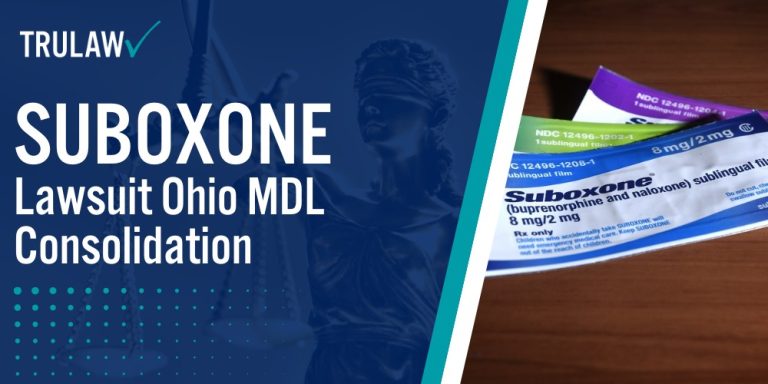
Intro to the Suboxone Lawsuit Ohio
The key aspects of the Suboxone MDL 3092 include, but are not limited to:
- Links between Suboxone and severe tooth decay
- Failure to adequately warn about potential risks
- Broad impact on public health and opioid crisis
- Consolidation of individual claims into multidistrict litigation (MDL)
If you have experienced significant dental problems like tooth loss or oral infections while taking Suboxone, you may qualify to pursue compensation.
Contact TruLaw using the chat on this page to receive an instant case evaluation and determine if you are eligible to join the Suboxone MDL today.
Table of Contents
Suboxone Lawsuit in Ohio Targets Pharmaceutical Companies
The Suboxone lawsuit in Ohio represents a major legal battle against prominent pharmaceutical companies accused of deceptive marketing and monopolistic practices.
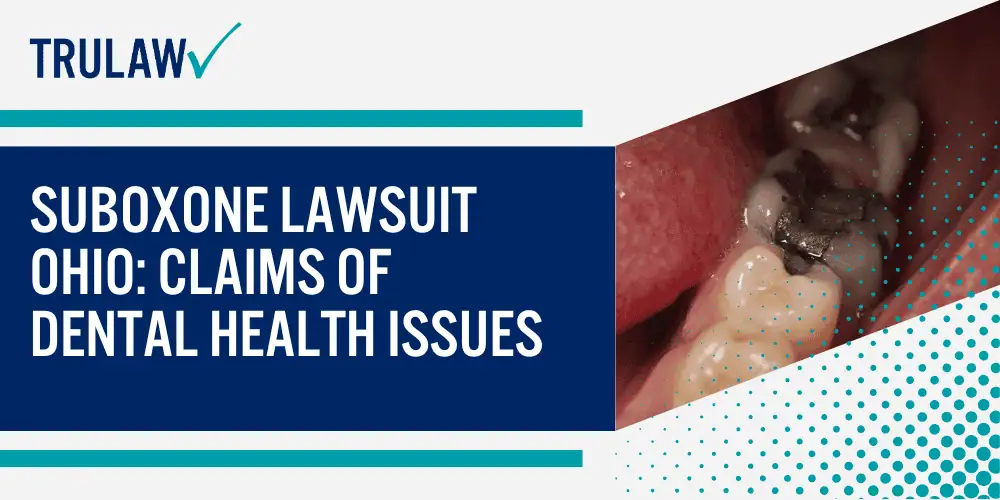
Ohio has become a central focus in the national effort to hold Suboxone manufacturers accountable for their role in the opioid crisis.
Allegations Against Suboxone Manufacturers
The core of the Suboxone lawsuit in Ohio involves several allegations against the manufacturers.
These claims highlight how pharmaceutical companies allegedly prioritized profits over patient safety.
The lawsuit aims to expose and rectify the practices that have contributed to widespread harm across the state.
These allegations include, but are not limited to:
- Deceptive Marketing Practices: Pharmaceutical companies are accused of misleading healthcare providers and patients about the safety and efficacy of Suboxone, particularly regarding its use as an opioid dependency treatment.
- Failure to Adequately Warn: Claims have been made that the companies did not provide sufficient warnings about the potential risks associated with Suboxone use, including the risk of dependency and the drug’s impact on dental health.
- Suboxone Tooth Decay: The FDA claims that Suboxone manufacturers failed to disclose the risks of severe dental decay associated with prolonged use of the medication, leading to significant dental issues for many patients across Ohio.
These allegations form the foundation of the legal action taken against the manufacturers, highlighting the extent of their alleged involvement in unethical practices that have worsened the opioid crisis nationwide.
Progress and Updates on Suboxone Lawsuit Ohio
The Suboxone lawsuit in Ohio has advanced notably, with a growing number of cases being consolidated into multidistrict litigation (MDL) in the Northern District of Ohio.
This consolidation is intended to organize pretrial proceedings, making it more manageable for plaintiffs to bring their suboxone tooth decay claims against Indivior Inc., the manufacturer of Suboxone.
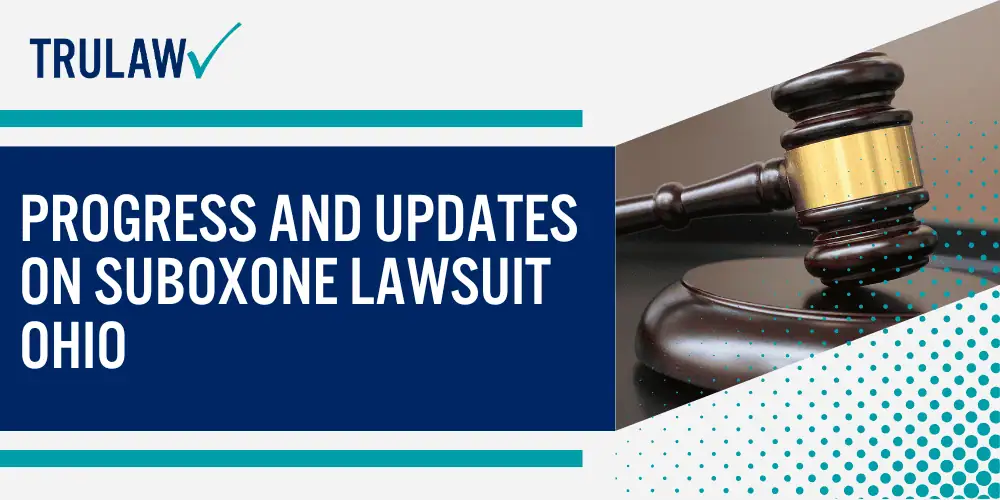
As new cases emerge and the courts issue rulings, the trajectory of Suboxone tooth decay litigation continues to evolve.
Key Court Decisions in the Suboxone Lawsuit Ohio
In 2024, the U.S. Judicial Panel on Multidistrict Litigation (JPML) centralized all federal Suboxone tooth decay lawsuits under Judge Philip Calabrese in the Northern District of Ohio.
This move was designed to handle the increasing number of federal Suboxone lawsuits efficiently, with over 673 cases already consolidated.
The consolidation has enabled coordinated discovery and pretrial activities, which are important for the numerous claimants involved.
Notable developments in the lawsuit include:
- Consolidation of Cases: On February 2, 2024, the JPML issued an order to centralize all tooth decay Suboxone lawsuits into the Northern District of Ohio.
- Statute of Limitations and Filing Deadlines: The impending statute of limitations for product liability has driven a wave of filings, particularly in states with shorter deadlines.
- Judicial Proceedings and Discovery: Judge Calabrese has overseen the coordination of pretrial activities, issuing orders to establish deadlines for discovery, expert witness disclosures, and motion filings.
These developments demonstrate the court’s commitment to moving the litigation forward and providing a clear process for the plaintiffs.
Impact of the Suboxone Lawsuit Ohio on Nationwide Litigation
The progress of the Suboxone class action lawsuit in Ohio is influencing similar litigation efforts nationwide.
Consolidating cases into the Suboxone MDL has organized the legal process and established a model for managing large-scale pharmaceutical litigation.
The coordination of discovery and pretrial activities under a single judge allows for consistent rulings, which can set precedents that affect other courts handling related cases.
Furthermore, the urgency surrounding the statute of limitations has highlighted the importance of timely filing, especially in states with strict deadlines.
The surge in filings before the June 2024 deadline in states with two-year statutes of limitations underscores potential plaintiffs’ need to act promptly to preserve their legal rights.
As the number of cases increases, Indivior is under increasing pressure to consider settlement options, potentially leading to negotiations that could resolve a substantial portion of these claims.
The impact of Suboxone litigation extends beyond Ohio and shapes the broader national dialogue on pharmaceutical liability and patient safety.
The outcomes of these cases are likely to influence future regulatory actions and corporate practices, particularly concerning the disclosure of potential drug risks.
Suboxone Lawsuit Ohio: Claims of Dental Health Issues
The Suboxone tooth decay lawsuit in Ohio has brought to light serious allegations regarding the drug’s impact on dental health.
Plaintiffs across the state claim that Suboxone, a medication primarily used for opioid addiction treatment, has caused severe dental problems, including tooth decay, loss, and oral infections.
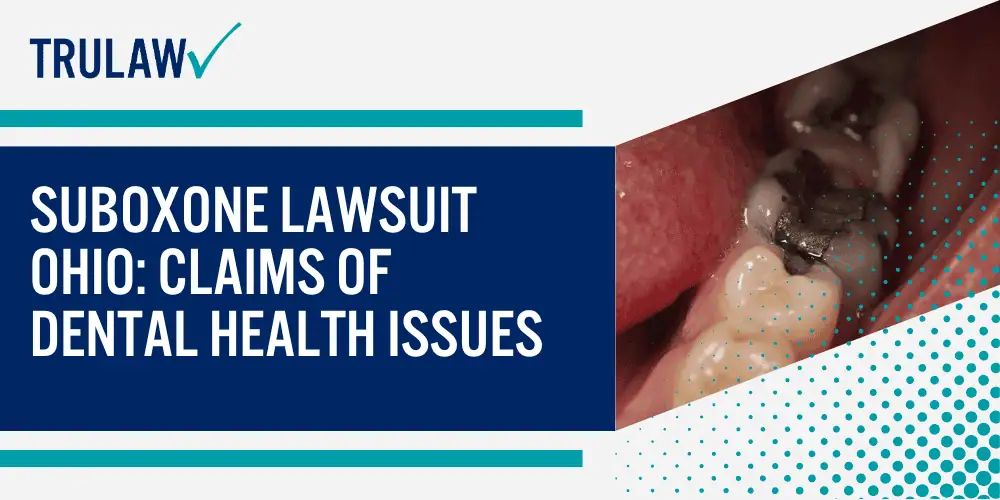
These lawsuits focus on Indivior Inc. allegedly failing to warn consumers and healthcare providers about these risks adequately.
Suboxone Tooth Decay Claims Against Indivior
One of the central issues in the Suboxone lawsuits is the drug’s association with severe dental health problems.
Suboxone, particularly in its sublingual film form, has been linked to significant issues such as tooth decay and loss.
Plaintiffs allege that these problems occurred even in individuals with no prior history of dental issues, raising concerns about the drug’s formulation and the manufacturer’s responsibility.
The lawsuits argue that the Suboxone sublingual films that dissolve under the tongue are highly acidic and can lead to dental erosion.
Despite numerous reports of dental health issues, the FDA did not mandate a warning about the risk of severe tooth decay on Suboxone’s labeling until June 2022.
This delay in issuing a warning has been a focal point in the legal action, with plaintiffs contending that earlier disclosure could have prevented much of the harm experienced by Suboxone users.
As the litigation progresses, consolidating these cases into multidistrict litigation (MDL) in the Northern District of Ohio has streamlined the pretrial process.
This consolidation is expected to facilitate a more efficient resolution of the claims, potentially leading to settlements or verdicts that address the extensive dental damage reported by plaintiffs.
Consumer Protection Claims in the Suboxone Lawsuit Ohio
The consumer protection aspect of the Suboxone lawsuits is closely tied to the allegations of dental health issues.
Plaintiffs argue that Indivior failed to provide sufficient warnings about the risks associated with Suboxone, particularly regarding its potential to cause severe dental problems.
This failure to warn is seen as a violation of consumer protection laws, as it left patients and healthcare providers unaware of the risks, leading to widespread harm.
Many plaintiffs have undergone extensive dental procedures as a result of Suboxone film use, including tooth extractions, root canals, and the use of dentures.
These severe dental injuries have led to claims for compensation to cover the costs of these treatments, as well as for the pain and suffering endured by the plaintiffs.
The lawsuits seek to hold Indivior accountable for its alleged negligence in failing to properly inform consumers about the risks associated with its product.
These consumer protection claims are vital to the ongoing litigation, as they aim to address the broader impact of Suboxone’s side effects on the public.
The outcomes of these cases may lead to further regulatory scrutiny and potentially set new standards for how pharmaceutical companies must communicate the risks of their products to consumers.
Public Health and Suboxone: Legal Implications Nationwide
The ongoing Suboxone lawsuit has not only highlighted the drug’s impact on individual users but has also raised significant concerns about public health on a national scale, particularly in the context of the United States’ battle with the opioid crisis.
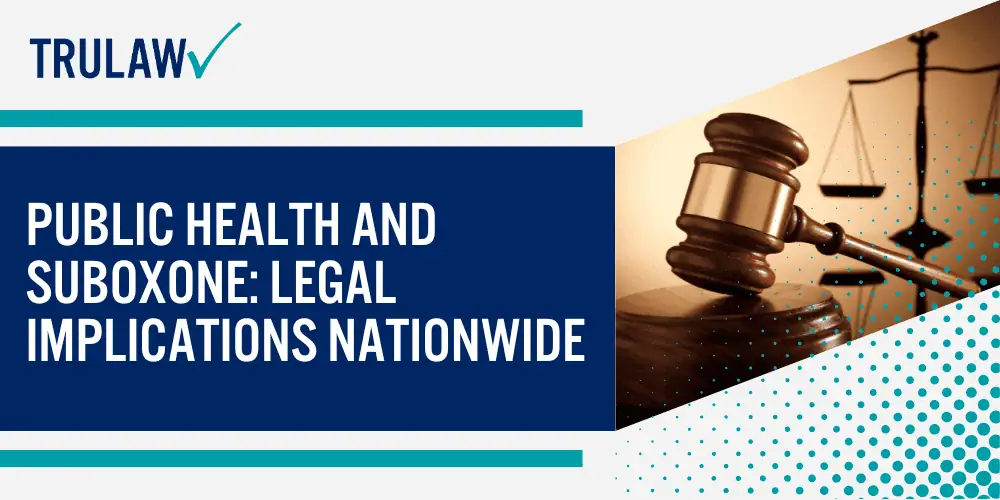
As the litigation unfolds, it underscores the complex interplay between legal accountability and public health efforts, revealing nationwide challenges and opportunities for healthcare systems.
Impact of Suboxone Lawsuit on the Opioid Crisis
Suboxone, a medication extensively utilized to treat opioid addiction, has significantly contributed to addressing the opioid epidemic in the United States.
However, challenges have arisen due to the profound dental issues of Suboxone tablets and their sublingual film.
Lawsuits have emerged, claiming that while Suboxone is effective in managing opioid dependency, it has also caused unintended harm in the form of tooth decay, erosion, and loss.
These actions focus specifically on:
- Balancing Benefits and Risks: Healthcare providers across the country now face the challenge of weighing Suboxone’s effectiveness in managing opioid dependency against the risks posed by its dental side effects.
- Importance of Patient Education: The situation underscores the need for comprehensive patient education, ensuring that individuals are fully aware of the potential risks associated with Suboxone use.
- Informed Consent: These developments highlight informed consent, particularly when prescribing treatments that carry known risks, to ensure patients can make well-informed decisions about their healthcare.
The attention drawn to the drug’s side effects by these lawsuits may prompt healthcare providers to seek alternative treatments or adjust their prescribing practices.
This shift could have widespread implications for how opioid addiction is managed across the United States, where effective treatment alternatives are needed.
Healthcare System Response to Suboxone Litigation
In response to the Suboxone litigation, healthcare systems across the United States have begun to adapt, recognizing the dual challenges of addressing opioid addiction while managing the side effects associated with treatments like Suboxone.
The lawsuits have prompted healthcare providers to reassess their approach to patient care, particularly in monitoring and preventing dental health issues linked to Suboxone use.
Medical facilities nationwide are increasingly incorporating dental assessments into the overall treatment plans for patients using Suboxone.
This proactive approach mitigates potential dental damage by identifying issues early and providing necessary dental care.
Additionally, healthcare providers are emphasizing the importance of oral hygiene and regular dental check-ups for patients prescribed Suboxone, which could help prevent severe dental complications.
Furthermore, the legal implications of the Suboxone lawsuits have led to a heightened focus on transparent communication between healthcare providers and patients.
Ensuring that patients are fully informed about the risks associated with their treatment options is becoming a standard practice, which could improve patient outcomes and reduce the likelihood of future litigation.
The response of healthcare systems to the Suboxone litigation reflects a broader shift towards more integrated care across the United States.
By addressing the side effects of addiction treatments more comprehensively, healthcare providers are setting a nationwide precedent for managing similar challenges in the future.
Compensation and Settlements in Suboxone Lawsuit Ohio
As the Suboxone litigation progresses, many plaintiffs in Ohio are seeking compensation for the severe dental injuries they have sustained due to the drug’s use.
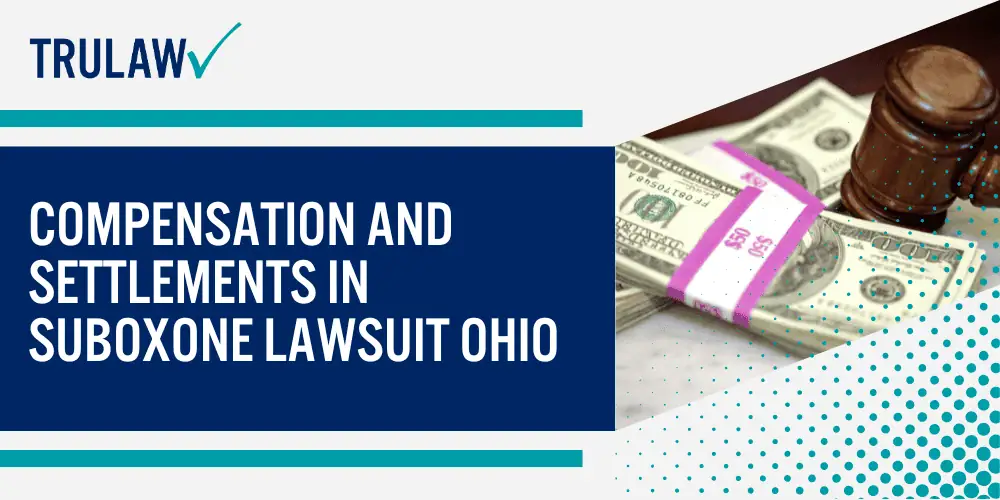
The multidistrict litigation (MDL) process will determine how these claims will be resolved, with the potential for compensation.
Potential Compensation for Ohio Plaintiffs in Suboxone Cases
Plaintiffs involved in the Suboxone lawsuits in Ohio may be eligible for compensation if they can prove that the medication caused severe dental issues such as tooth decay, erosion, or loss.
The multidistrict litigation (MDL) process is designed to streamline these cases, potentially leading to settlements that compensate for the plaintiffs’ harm.
Compensation in these cases typically covers:
- Medical Expenses: Reimbursement for dental treatments, including tooth extractions, fillings, root canals, and other necessary procedures to address the damage attributed to the use of prescription Suboxone film.
- Pain and Suffering: Monetary compensation for the physical pain and emotional distress experienced due to dental injuries.
- Loss of Quality of Life: Compensation for the impact that severe dental issues may have on the plaintiff’s ability to enjoy life and engage in daily activities.
- Punitive Damages: In some cases, the court may award punitive damages if it is determined that the manufacturer acted with gross negligence or willful misconduct in failing to warn about the risks associated with Suboxone.
The outcome of bellwether trials, which serve as test cases within the MDL, will likely influence the compensation amounts offered in settlements.
These trials help both plaintiffs and defendants gauge the strength of their cases, potentially leading to broader settlement discussions.
How to File a Claim in the Suboxone Lawsuit Ohio
Filing a claim in the Suboxone lawsuit in Ohio involves several important steps.
First, potential plaintiffs should consult with an experienced attorney specializing in product liability and mass tort litigation to evaluate their case and determine eligibility.
After establishing eligibility, plaintiffs will need to gather essential evidence, such as medical records, dental reports, and other documentation that links their dental injuries to Suboxone use.
With the guidance of their attorney, plaintiffs can then proceed to file the necessary legal documents to join the ongoing multidistrict litigation (MDL) or initiate a separate lawsuit if appropriate.
Throughout this process, plaintiffs should be prepared to participate in discovery activities, including providing testimony, attending depositions, and undergoing medical examinations.
Future Outlook for the Suboxone Lawsuit Ohio
The future of the Suboxone lawsuit in Ohio remains uncertain, with many factors influencing its potential outcomes.
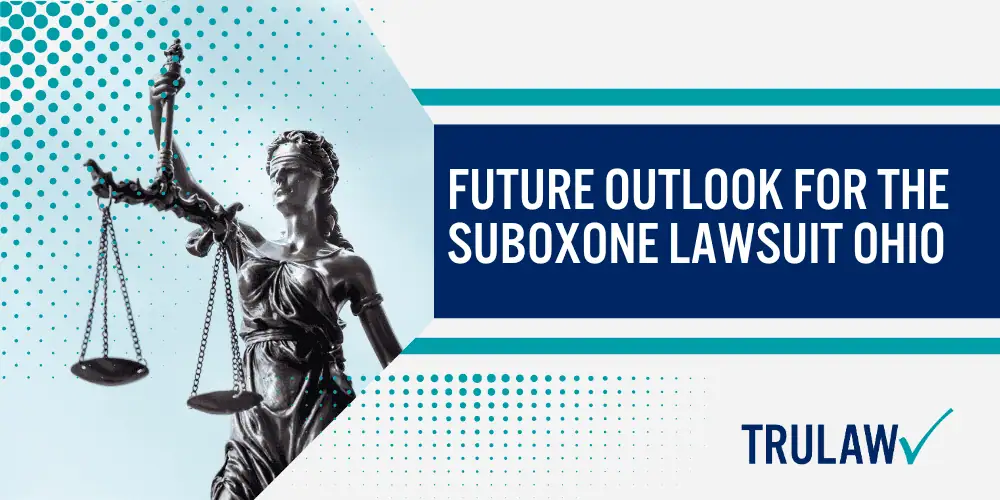
The progress of the bellwether trials within the MDL, regulatory responses, and the broader legal landscape all play crucial roles in determining how these cases will be resolved.
Potential Outcomes and Future Legal Battles in Ohio
The future of the Suboxone lawsuit in Ohio is closely tied to the outcomes of the bellwether trials scheduled within the MDL.
These trials are expected to set the tone for resolving the remaining cases.
Potential outcomes in the Suboxone lawsuit include, but are not limited to:
- Global Settlement: If the bellwether trials result in favorable outcomes for the plaintiffs, Indivior may be under increased pressure to negotiate a global settlement that would resolve a large number of cases collectively.
- Individual Trials: If a global settlement is not reached, cases may proceed to individual trials, where each plaintiff’s case will be adjudicated separately.
- Regulatory Changes: The ongoing litigation may prompt regulatory agencies to scrutinize Suboxone and similar medications further, potentially leading to stricter labeling requirements or additional warnings.
Acting promptly is important, as Ohio’s statute of limitations could affect the ability to file a claim, especially for those who discovered their injuries after the FDA’s warning about Suboxone’s dental risks.
Ohio Legal Community’s Perspective on the Suboxone Lawsuit
The legal community is closely watching the developments in the Suboxone lawsuit, recognizing its potential to shape future product liability litigation.
Lawyers in the case view the MDL as a critical step in holding pharmaceutical companies accountable for failing to warn about the risks associated with their products adequately.
The denial of phased discovery, for example, has been seen as a victory for plaintiffs, as it prevents unnecessary delays and ensures that the cases move forward in a timely manner.
Legal experts also anticipate that the outcomes of these Suboxone tooth decay cases could influence the broader legal landscape, particularly in how courts handle large-scale pharmaceutical litigation.
The decisions made in the Suboxone MDL may set precedents that affect future cases involving other medications with serious side effects.
Suboxone Lawsuit Frequently Asked Questions
-
No, there is no current Suboxone class action lawsuit.
Instead, individual personal injury claims related to dental issues allegedly caused by Suboxone are being consolidated into a multidistrict litigation (MDL) within the Northern District of Ohio.
-
The Suboxone Lawsuit in Ohio pertains to the failure to adequately warn about potential risks and the link between Suboxone and severe tooth decay.
The lawsuit aims to hold these companies accountable for their alleged role in the opioid crisis and the harm caused to patients in Ohio.
-
The core allegations in the Suboxone Lawsuit include deceptive marketing practices, physician-prescribed Suboxone film failure to warn about potential risks adequately, and the link between Suboxone and severe tooth decay.
These claims highlight how pharmaceutical companies allegedly prioritized profits over patient safety.
-
The Ohio Attorney General has played a central role in advancing the Suboxone Lawsuit, taking an active stance in the fight against opioid addiction within the state.
The Attorney General’s office has sought to hold pharmaceutical companies accountable and has collaborated with other states to coordinate efforts against Suboxone manufacturers.
-
Plaintiffs of the Suboxone MDL in Ohio claim that the drug, particularly in its sublingual film form, has caused severe dental problems such as tooth decay, loss, and oral infections.
These lawsuits argue that Suboxone’s highly acidic nature can lead to significant dental erosion.
-
To file a claim in the Suboxone MDL, potential plaintiffs should consult with an experienced attorney specializing in product liability and mass tort litigation.
After establishing eligibility and gathering necessary evidence, plaintiffs can join the ongoing multidistrict litigation (MDL) or initiate a separate lawsuit with the guidance of their attorney.

Managing Attorney & Owner
With over 25 years of legal experience, Jessica Paluch-Hoerman is an Illinois lawyer, a CPA, and a mother of three. She spent the first decade of her career working as an international tax attorney at Deloitte.
In 2009, Jessie co-founded her own law firm with her husband – which has scaled to over 30 employees since its conception.
In 2016, Jessie founded TruLaw, which allows her to collaborate with attorneys and legal experts across the United States on a daily basis. This hypervaluable network of experts is what enables her to share the most reliable, accurate, and up-to-date legal information with our readers!
Additional Suboxone Lawsuit resources on our website:
Here, at TruLaw, we’re committed to helping victims get the justice they deserve.
Alongside our partner law firms, we have successfully collected over $3 Billion in verdicts and settlements on behalf of injured individuals.
Would you like our help?
At TruLaw, we fiercely combat corporations that endanger individuals’ well-being. If you’ve suffered injuries and believe these well-funded entities should be held accountable, we’re here for you.
With TruLaw, you gain access to successful and seasoned lawyers who maximize your chances of success. Our lawyers invest in you—they do not receive a dime until your lawsuit reaches a successful resolution!
AFFF Lawsuit claims are being filed against manufacturers of aqueous film-forming foam (AFFF), commonly used in firefighting.
Claims allege that companies such as 3M, DuPont, and Tyco Fire Products failed to adequately warn users about the potential dangers of AFFF exposure — including increased risks of various cancers and diseases.
Depo Provera Lawsuit claims are being filed by individuals who allege they developed meningioma (a type of brain tumor) after receiving Depo-Provera birth control injections.
A 2024 study found that women using Depo-Provera for at least 1 year are five times more likely to develop meningioma brain tumors compared to those not using the drug.
Suboxone Tooth Decay Lawsuit claims are being filed against Indivior, the manufacturer of Suboxone, a medication used to treat opioid addiction.
Claims allege that Indivior failed to adequately warn users about the potential dangers of severe tooth decay and dental injuries associated with Suboxone’s sublingual film version.
Social Media Harm Lawsuits are being filed against social media companies for allegedly causing mental health issues in children and teens.
Claims allege that companies like Meta, Google, ByteDance, and Snap designed addictive platforms that led to anxiety, depression, and other mental health issues without adequately warning users or parents.
Transvaginal Mesh Lawsuits are being filed against manufacturers of transvaginal mesh products used to treat pelvic organ prolapse (POP) and stress urinary incontinence (SUI).
Claims allege that companies like Ethicon, C.R. Bard, and Boston Scientific failed to adequately warn about potential dangers — including erosion, pain, and infection.
Bair Hugger Warming Blanket Lawsuits involve claims against 3M — alleging their surgical warming blankets caused severe infections and complications (particularly in hip and knee replacement surgeries).
Plaintiffs claim 3M failed to warn about potential risks — despite knowing about increased risk of deep joint infections since 2011.
Baby Formula NEC Lawsuit claims are being filed against manufacturers of cow’s milk-based baby formula products.
Claims allege that companies like Abbott Laboratories (Similac) and Mead Johnson & Company (Enfamil) failed to warn about the increased risk of necrotizing enterocolitis (NEC) in premature infants.
Here, at TruLaw, we’re committed to helping victims get the justice they deserve.
Alongside our partner law firms, we have successfully collected over $3 Billion in verdicts and settlements on behalf of injured individuals.
Would you like our help?
